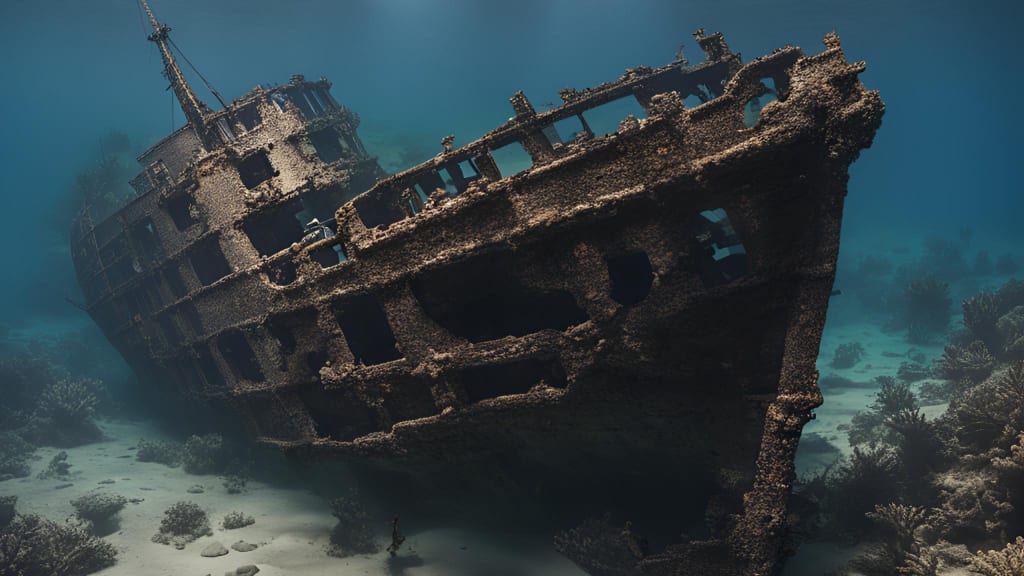
Throughout history, ships have been created for a variety of purposes including small sailing boats, gigantic cruise liners and powerful warships.
The Pesse Canoe is the oldest known water faring vessel, created during the Mesolithic Period in 8000 BCE making it 10,020 years old!
Ships have transported travellers and treasures. Pirates have carved out legacies of terror and wars have been fought above and below its waves.
While created with high levels of craftmanship to keep them afloat and minimise the risk of an accident or sinking occurring, it is estimated that 3 million vessels have been lost below the waters.
Many have been found again, raised up from the depths and displayed in nautical museums while others have been left as an underwater gravesite marker. They are some that have been reported in ghostly sightings and some are still missing, waiting to be found again.
Here are 9 Famous Shipwrecks Throughout History Part 1:
1. The Titanic
The Titanic began construction in Belfast, Northern Ireland in 1909 and set off on her maiden voyage on April 10th 1912 and sank just 4 days later on April 14th 1912 after hitting an iceberg in the North Atlantic Ocean off the coast of Newfoundland, Canada.
Titanic sank in under 3 hours and was carrying an estimated total of 2259 personnel on board, of which only 713 survived. At the time it was declared as the greatest loss of life in a nautical accident.
Following her sinking, new laws were put in place to prevent such a tragedy occurring again. These included enough lifeboats for all passengers, a radio room manned 24/7 and evacuations to be completed within 30 minutes.
Her final resting place remained undiscovered until 1985 when it was found by a team led by Dr Robert Ballad. While many artefacts have been recovered, personal items have been left untouched out of respect for both the survivors and those who lost their lives.
An ongoing debate as to whether Titanic should be raised or remain under the waves as a gravesite is due to decay of the wreck that will one day cause The Titanic to disappear completely.
An eerie fact also surrounding the sinking of the Titanic that exists in the form of a novella released in 1898 called Futility which was then changed to The Wreck of the Titan in 1912 by Morgan Robertson. The novella eerily seems to predict the Titanic’s fate. Both ships were labelled as “Unsinkable”, were a similar size [Titan was 800ft and Titanic was 882ft], neither ship had enough life boats and both sunk after a collision with an iceberg in the North Atlantic Sea in April! A final similarity is that when the Titan hit the iceberg it was moving at 25 knots and struck the iceberg on its starboard side, 400 nautical miles from Newfoundland and The Titanic?
Yep, it was moving at 22.5 knots and struck the iceberg on its starboard side, 400 nautical miles from Newfoundland!
Morgan denied speculation that he precognitive abilities but the similarities are eerily accurate!
2. The Fleet of Kublai Khan
Kublai Khan was the grandson of Mongolian Warrior-Ruler Genghis Khan and inherited the Mongolian Empire created by Genghis and became the first Mongolian to conquer China in 1279.
Kublai set to expand his empire with Japan and sent two fleets in 1274 and 1281 to conquer them.
Both times many of the ships were destroyed by powerful typhoons or as the Japanese called them Kamikaze or Divine Winds that prevented many of the Mongolian Forces from landing.
In the 1980’s, Dr Torao Mozai located the resting site of the fleet near to Takashima Island and in the 1990’s archaeologists led by Kenzo Hayashida discovered an intact wreck of one of the ships.
Excavations into the wrecks discovered artefacts including pottery, timber shards, weapons, armour and cannonballs. Archaeologists have stated that the wrecks will hopefully allow them to see how the Mongolian Empire crafted ships in their time.
3. The Spanish Armada
Religious tensions between England and Spain in the mid-16th Century were escalating as Queen Elizabeth 1 of England was a Protestant and King Philip II of Spain was a Catholic.
Philip wanted to marry her to have an heir that would return England to Catholicism. By 1588, Philip decided that rather than marry Elizabeth he would invade and install his daughter Isabella as Queen of England.
In May 1588, 130 ships set sail carrying 30,000 men and reached England on July 31st 1588 where both sides engaged in naval warfare. While the English ships were seriously under gunned, they managed to keep the armada at bay and forced the Spanish to retreat to France following days of a stalemate.
England pursued them and let the wind blow empty ships set on fire into the anchored armada causing them to retreat once again to the open sea.
A lack of supplies and disease forced them to abandon the invasion completely and return home. During this journey, the armada lost half of its ship and personnel to violent storms in what came to know as one of the Greatest Naval Military Blunders in history.
Many of the wrecks of these ships can be found in the waters surrounding the UK coast with salvage operations being carried out to preserve them and the history they represent.
4. RMS Empress of Ireland
The RMS Empress of Ireland was built in 1906 for the Canadian Pacific Railways and enjoyed 8 years transporting passengers across the Atlantic Sea in 6 days which was very impressive at the time.
On May 28th 1914, Empress set off with 1477 people on board and proceed down the St. Lawrence River. By the morning of May 29th at 1.38 am, the lights of the SS Storstad were seen towards the Empress’ starboard bow. The Empress adjusted her course to allows the Storstad to pass safely, moments later a very dense fog enveloped the river and both ships and at 1.55am the Storstad reappeared suddenly and struck the Empress slicing in her side.
Water began pouring in at high speed and many of the passengers on the starboard side were drowned instantly. Empress sank so rapidly that only 6 lifeboats could be launched.
It only took 15 minutes for the Empress to sink completely but by this time 1012 people had perished to drowning or the icy cold river.
The tragedy was labelled as Canada’s Worst Peacetime Naval Disasters of all time and she gained the nickname of “Canada’s Titanic.” Empress also highlighted how labelling a ship as “unsinkable” was becoming an issue, as two “Unsinkable Ships” had become shipwrecks within two years of each other.
The Empress of Ireland was mainly forgotten as on 28th July 1914, World War 1 began and its high death count dominated the news for 4 years overshadowing the lives lost in the sinking of Empress.
5. MS Estonia
On the 27th September 1994, the passenger ferry MS Estonia left Estonia on a route to Sweden with a total of 989 people of board across the Baltic Sea.
Estonia faced conditions causing high waves to crash into her. At 1.00am on the 28th September, a crewman reported a loud bang from the bow of the ship but showed no evidence of damage.
Minutes after the first bang, passengers and crew started reporting strange noises and bangs and at 1.15am the visor separated from the bow and pulled open the car ramp allowing water to rapidly enter the ship causing a tilt to its starboard side and trapping many personnel on that side.
A mayday alert was raised at 1.22am but Estonia was sinking at a rapid rate and by the time the first rescue helicopter arrived at 3.05am, Estonia had sunk completely.
Freezing seawater, rapid sinking rate and inability to launch any lifeboats, saw only 137 people survive with 852 people losing their lives and only 92 bodies being recovered.
6. The Andrea Doria
In 1956, The Andrea Doria was called the most beautiful Ocean Liner of her time and completed 100 Transatlantic Journeys.
On July 25th 1956, she entered the Northeast Coast shipping lanes near New York City. At the same time the Stockholm was departing New York. At around 10.30pm, both were heading towards each other with Andrea travelling at a slower speed and Stockholm travelling faster than normal.
At 10.45pm, they detected each other via radar screens yet both interpreted their positions incorrectly and plotted a course straight towards one another.
At 11.10pm, Stockholm came speeding out of the fog that night directly towards the Andrea and crashed into her causing an almost 30ft hole in her side.
Both crews scrambled to start emergency procedures and while it was clear Stockholm was stable, Andrea was beginning to sink. Luckily nearby ships in the shipping lane responded to the mayday alert and proceeded to begin rescuing passengers from the sinking ship.
Of the 1706 people on board, 1655 people were rescued and 51 people lost their lives, 46 from the Andrea and 5 from the Stockholm.
The wreck has become known as the Mt. Everest of Wrecks as it has notoriously hazardous underwater conditions that prevent casual divers from attempting to reach the wreck and only highly experienced divers are granted permission to dive. Since 1956, around 20 people have died or gone missing while attempting to reach the wreck.
7. MV Dona Paz
While The Titanic is the most famous shipwreck in Naval History, it was not the deadliest.
MV Dona Paz was a passenger ferry that undertook a journey from Leyte Island to Manila. On December 20th 1987, Dona Paz began her journey into what later became known as “Hell at Sea”.
Dona’s capacity was around 1584 people but due to the holiday season around 4000 people were being carried that day, many of whom had purchased tickets illegally.
That night, Dona Paz collided with MT Vector, an oil tanker carrying 9000 barrels of gasoline and petroleum products that upon the collision between the two vessels, erupted into a fireball that quickly consumed both ships burning.
Many of the passengers and crew of the two ships were burnt alive. Some jumped into the water to escape but the oil had coated the water setting it aflame causing more to be burned to death or taken by the sharks that inhabit the area.
Both ships sank within 4 hours and rescue operations arrived a further 4 hours afterwards, saving only 26 people with an estimated total of 4386 people losing their lives in what is called The Deadliest Naval Peacetime Disaster in History.
8. Nuestra Senora de las Mercedes
The Nuestra Senora de las Mercedes was a Spanish Galleon Ship transporting cargo across the Atlantic Sea and was part of The Spanish Armada during the 19th Century.
In October 1804, Nuestra was transporting a cargo of Gold, Silver, Spices and Fabrics when it was intercepted by ships belonging to the British Navy just off the coast of Portugal.
Despite Spain and Britain being at peace with one another, the Spanish Ships senior officer refused to change course to England as instructed by the British Ships commander and opened fire on them.
The Battle of Cape Santa Maria was short lived with the Nuestra sinking during the fight and taking part of the cargo under the water as well.
The cargo was estimated to be worth at the time as £1,010,684 in Silver, Wool, Bars of Tin, and Pigs of Copper that belonged to the Spanish King and £865,395 in Gold, £1,437,007 in Silver, £115,945 in Gold Ingots that belonged to Merchants.
During the 20th Century, the wreck of Nuestra became a highly sought-after location because of the treasure the wreck contained.
In 2007, a Florida shipping company called Odyssey announced they had found a shipwreck codenamed The Black Swan and had managed to salvage and remove treasure back to the US that was worth around £314 million at the time.
When the Nuestra was revealed as the shipwreck, Spain set out to recover the treasure which they stated legally belonged to them. Over the next 5 years Odyssey attempted to block all legal actions to keep the treasure but were ordered by the U.S Supreme Court to return all the treasure to Spain.
The Nuestra de las Mercedes treasures can now be seen on display in museums through Spain.
9. The Black Sea Shipwrecks
In 2016, scientists were investigating the Black Sea to study how changes to sea-levels affected early human societies around 12,000 years ago.
During a survey of the seabed, they discovered three perfectly preserved shipwrecks dating back to the 2nd Century. During the next 3 years a total of 67 preserved shipwrecks were located that spanned over a thousand years of History.
In 2018, a wreck from Ancient Greece was located, awarding it the title of The Oldest Surviving Shipwreck from the Classical World and is 2420 years old.
The ships are preserved so well due to the unique composition of the area in which they lay that is 500 feet below sea level and almost devoid of oxygen that causes decay to many shipwrecks.
These wrecks are in such perfectly preserved condition, that even minute details such as chisel marks can still be seen and are fantastic windows into bygone historical times.
About the Creator
Ryan McGregor
I am a writer based in the UK. I specialise in writing film, tv and fiction scripts based in the Horror, Sci-Fi and Fantasy Genres! I first began writing on a regular basis during 2020 and love to create mainly short stories!
Enjoyed the story? Support the Creator.
Subscribe for free to receive all their stories in your feed. You could also pledge your support or give them a one-off tip, letting them know you appreciate their work.






Comments
There are no comments for this story
Be the first to respond and start the conversation.